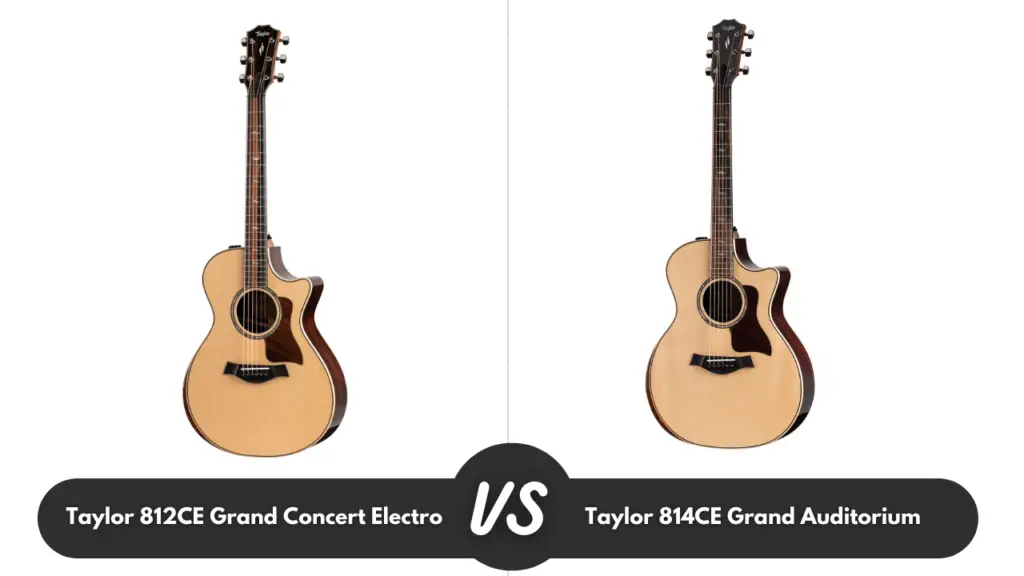Regardless of whether you’re a beginner or a professional guitar player with decades of experience under your belt, it’s always hard to ignore the “wow” factor once you see a premium high-end acoustic guitar. But, once you get past the initial astonishment and dig a little deeper, you see the price tag and start to wonder if it’s actually worth the money.
However, when it comes to Taylor guitars which are considered to be a premium acoustic guitar brand, you know that you’re paying that extra price for the superior sound and playability, but also the high build quality, tonewoods, quality of the hardware, as well as looks.
With being said, let’s take a quick look at two popular Taylor models, the 812CE and 814CE, and see which one may be better for you.
| Features: | Taylor 812CE Grand Concert Electro | Taylor 814CE Grand Auditorium Cutaway Electro |
|---|---|---|
| Price: | £3,799 | £3,599 |
| Frets: | 20 | 20 |
| Top: | Sitka Spruce | Sitka Spruce |
| Back & Sides: | Indian Rosewood | Indian Rosewood |
| Bracing: | V-Class | V-Class |
Taylor 812CE
Taylor’s 812CE is part of Taylor’s new version from the 2014 800 series. The 812CE features solid Rosewood back and sides and a solid Sitka Spruce top, widely accepted as the de facto ‘standard’ for achieving an acoustic tone that’s warm with plenty of body and just the right amount of sparkle and snap.
Build
Despite the many changes the 812CE has gone through over the years, it has had the same fundamental design concept as the guitar introduced almost 40 years ago, with it still featuring the compact grand-concert body built with Indian rosewood back and sides and a Sitka spruce top
Residing towards the higher end of Taylor’s line, the woods used for the 812CE are top-shelf.
As Taylor has done a few models in recent years, the 812CE has a highly figured and striped ebony fingerboard, which, with the “element” position markers and ebony peghead overlay, gives the guitar a distinguished appearance. While the current guitar swaps out Gotoh tuners that were part of the Deluxe edition for standard Taylor-branded tuning machines, and with the addition of an Indian rosewood armrest, bevel essentially means that the standard model is now on par with the former upgraded version.
Performance
Taylor’s 812CE is incredibly easy to play and, as has always been the case with the model, it is able to cover a lot of musical ground. The V-Class bracing that Taylor provides gives it great clarity and very controlled overtones, producing a precise tonal quality. Although it’s not as powerful or loud as some larger guitars, the 812CE defiantly doesn’t sound small at all; it has an outstanding balance with satisfying lows, and it never becomes woofy or muddy, even while big chords are being played. This guitar is highly capable of being a fingerstyle machine, but it’s also fun to play electric-style leads and has no problem with most strumming duties.
Without a doubt, the newest 812CE version is the most advanced version of the model yet. Anyone looking for a comfortable guitar with a versatile and friendly tonal character would do well to check it out.
Taylor 814CE
From the very early days, Taylor’s innovation has been key to the brand’s success. From the use of modern computer-driven machinery – Taylor’s first CNC router was originally recommended by Tom Anderson – through to UV finishing and, not least, the NT neck joint, which has allowed for a level of consistency and repair, should it be needed, and that remains quite unique.
Build
There’s a raft of cosmetic changes to the modern 814CE. The headstock facing moves from rosewood to jet-black ebony and is finished with gloss. The binding around the head, the fingerboard and body edges are still maple however, by design, it’s plainer and unfigured.
Conversely, the ebony fingerboard of the 814CE is noticeably streaked, ‘smoky’, and features new ‘Element’ inlays – less fancy than the ‘diamond-like’ inlays from the previous version. The soundhole rosette still has an abalone centre, although it’s edged inside and out with rosewood, while the actual soundhole gets a maple-bound edge.
Overall, there’s a noticeable difference in the weight of the guitar. For example, it’s 300g lighter than the 714ce, and 200g lighter than Taylor’s 2013, smaller-bodied 812CE. Finally, the hardly thick UV-cured polyester finish has been halved to around 3.5 thousandths of an inch, which is about the same thickness as a piece of paper.
Taylor’s Expression System has received a complete redesign – moving away from the soundboard and neck-placed magnetic sensors that were on the original design back to piezos.
Performance
Part of the reason why Taylor’s Grand Auditorium body style has been so popular is that it’s an all-rounder. Taylor guitars have a family resemblance sound-wise: brighter or more hi-fi- sounding that is an equivalent to a Martin.
It concerns the mids, which sound bolder and less ‘scooped’. Not least with the new-gauge strings, there’s also some more thickness to the highs, and the guitar feels like it’s got more to give, volume-wise.
When you plug the 814CE in, the first thing you’ll notice over an amp is a much stronger output, even when using a balanced TRS cable on the previous system. When it comes to the lower mids, they’re bolder with a thicker sound.
Conclusion
Taylor’s 812CE tends to come out on top slightly, mostly due to how comfortable it is to play. Many believe the 812CE to be louder than the 814CE with a bit more bass response. The 812CE is great for strumming or fingerpicking and sounds great when amped as well.
